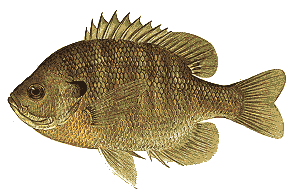

Latin name: Lepomis macrochirus Rafinesque
Other names: sunperch, blue sunfish, copperbelly, copperhead, coppernose bream, redbreasted sunfish, yellowbelly, bluemouth sunfish, baldface, plumb granny, pumpkinseed, pond perch.
Bluegill is the most abundant and widespread member of the sunfish family. It is found in nearly all waters of the state but is far more abundant in lakes and ponds than in streams and rivers. It is very abundant in the backwaters and sloughs of the Mississippi River.
The bluegill is a deep, slab-sided sunfish with a rather small mouth. The upper jaw does not reach the front of the eye when the mouth is closed. The spiny dorsal fin has 10 spines and is joined broadly to the soft dorsal fin, but there is no notch. The pectoral fins are long and pointed and extend past the eye when they are bent in a forward position. There is usually a black spot or blotch near the base of the soft dorsal fin and a black flexible tip on the gill cover. The back and sides are colored dark olive green with emerald and brownish reflections. The breast and belly are yellow or reddish-orange. Males in breeding colors often have a deep red, almost dark brown breast. The side usually display vertical bars, but these are more prominent in smaller fish. The gill covers and chin are bright blue, giving the bluegill its name.
Bluegills consume zooplankton when young, but switch to aquatic insects after they are mature. The small-sized mouth of this fish limits the size of food particles ingested and almost dictates a diet of insects and similar small organisms. While insects remain the staple food item for adults, crayfish, snails, small fish and fish eggs are also consumed. Algae and other vegetation are eaten when normal food items are scarce. Fish lice, Argulus, have been identified in bluegill stomach contents, indicating thet these fish may perform a "cleaning" function on heavily parasitized fish.
Bluegill reproduce over a wide time period, usually from late May to early August, but peak spawning occurs in early June. Water temperatures during the spawning season are 70 to 80 degrees Fahrenheit. Males construct nests in water from 1 to 4 feet in depth along the shoreline, over diverse substrate materials, but sand and gravel are preferred. The nests are saucer-shaped depressions about 1 to 2 feet in diameter. From the shore, the colony of nests resembles "elephant tracks". The pugnacious males often build nests, almost touching adjoining nests. It is quite common to find as many as 50 nests in a 75-foot radius. Most nests are only 2 to 3 inches deep, and the male fish keep them fanned free of silt.
After nest construction, the ripe male selects a gravid female and entices her toward the nest with aggressive nudges and bites. Few females lay all their eggs in one nest, so each nest contains the eggs of several females. The males zealously guard the nests from all intruders and keep the eggs free from silt. Sometimes bluegill hybridize with other members of the sunfish family: redear, green sunfish and pumpkinseed. Males make grunting noises during spawning and may be attracted to spawning areas by odor. Finer substrates produce the most fry per nest with an average of about 64,000 on sand and fine gravel.
Growth of bluegill varies widely with population density. High population density retards growth while the opposite occurs with low density. Bluegill will reach 1 to 2 inches in length on the average in their first year of life. Most bluegill attain lengths of 3.5, 4.5, and 6 inches in their second, third, and fourth year of life. Bluegills mature during the second year under suitable conditions, but slower growth will delay maturity to the third year. Bluegill attain a length of up to 12 inches and weigh up to 2 pounds, but most bluegill caught by anglers seldom exceed 8 inches.

